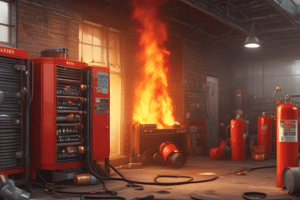Podcast
Questions and Answers
What key elements contribute to building a strong workplace safety culture?
What key elements contribute to building a strong workplace safety culture?
Management commitment and employee participation are key elements.
Why is open dialogue important in fostering workplace safety?
Why is open dialogue important in fostering workplace safety?
Open dialogue encourages reporting of near misses and creates a shared responsibility for safety.
What should a well-defined incident reporting system include?
What should a well-defined incident reporting system include?
It should include procedures for documenting incidents, collecting evidence, and starting investigations.
What is the significance of conducting safety compliance audits?
What is the significance of conducting safety compliance audits?
How do specific hazards in a workplace influence safety considerations?
How do specific hazards in a workplace influence safety considerations?
What role do investigations play in workplace safety?
What role do investigations play in workplace safety?
What can be the consequences of violating workplace safety regulations?
What can be the consequences of violating workplace safety regulations?
How can management demonstrate commitment to workplace safety?
How can management demonstrate commitment to workplace safety?
What is the primary goal of safety procedures in the workplace?
What is the primary goal of safety procedures in the workplace?
Describe the role of risk assessment in hazard management.
Describe the role of risk assessment in hazard management.
Why is comprehensive safety training important for employees?
Why is comprehensive safety training important for employees?
What should be considered when selecting Personal Protective Equipment (PPE)?
What should be considered when selecting Personal Protective Equipment (PPE)?
Explain the significance of maintaining training documentation for safety procedures.
Explain the significance of maintaining training documentation for safety procedures.
What should be the first step taken in mitigating high-risk areas identified during a risk assessment?
What should be the first step taken in mitigating high-risk areas identified during a risk assessment?
What is the importance of regularly reviewing and updating safety procedures?
What is the importance of regularly reviewing and updating safety procedures?
How can improper use of PPE affect personal safety in the workplace?
How can improper use of PPE affect personal safety in the workplace?
Flashcards
Hazard Identification
Hazard Identification
The process of recognizing and documenting potential sources of harm in the workplace.
Risk Assessment
Risk Assessment
Analyzing the likelihood and severity of potential harm from identified hazards. It helps prioritize risks for mitigation.
Workplace Safety Program
Workplace Safety Program
A set of programs, procedures, and practices designed to protect individuals, property, and the environment from hazards.
Safety Training
Safety Training
Signup and view all the flashcards
Personal Protective Equipment (PPE)
Personal Protective Equipment (PPE)
Signup and view all the flashcards
Emergency Preparedness
Emergency Preparedness
Signup and view all the flashcards
Hierarchy of Controls
Hierarchy of Controls
Signup and view all the flashcards
Emergency Response Plan
Emergency Response Plan
Signup and view all the flashcards
Workplace Safety Culture
Workplace Safety Culture
Signup and view all the flashcards
Incident Reporting
Incident Reporting
Signup and view all the flashcards
Incident Investigation
Incident Investigation
Signup and view all the flashcards
Regulatory Compliance
Regulatory Compliance
Signup and view all the flashcards
Safety Systems
Safety Systems
Signup and view all the flashcards
Employee Involvement
Employee Involvement
Signup and view all the flashcards
Study Notes
Safety Considerations
- Safety involves the avoidance, minimization, or control of hazards that can cause harm to individuals, property, or the environment.
- Safety procedures aim to prevent accidents, injuries, and negative consequences arising from various sources.
- A comprehensive safety program integrates various elements including risk assessment, hazard identification, safety training, and emergency response plans.
Hazard Identification & Risk Assessment
- Hazard identification involves recognizing and documenting potential sources of harm.
- This process typically includes examining equipment, procedures, and the work environment to identify hazards.
- Risk assessment analyzes the likelihood and severity of potential harm from identified hazards, producing a prioritized list of risks for mitigation.
- Factors considered in risk assessment often include the frequency and potential consequences of an event, such as injuries, property damage, environmental impacts or financial losses.
- Implementing appropriate control for high-risk areas should be the first step taken.
Safety Training and Procedures
- Comprehensive safety training programs are essential for employees working with potential hazards.
- Training should provide clear instructions on safe practices and procedures, including the correct use of equipment, personal protective equipment (PPE), and emergency response protocols.
- Properly maintained training documentation is required, showing that employees have completed appropriate training for the hazards of their job and workplace.
- Regular review and updates of safety procedures are important to ensure they remain effective in addressing evolving hazards and risks.
- Clear communication of safety protocols and procedures is crucial for workplace safety.
Personal Protective Equipment (PPE)
- PPE refers to equipment designed to protect individuals from hazards in the workplace.
- Examples include safety glasses, gloves, respirators, and hearing protection.
- PPE selection should be based on the specific hazards present in a given workplace environment and the appropriate hazard classes should be considered.
- PPE usage must align with established guidelines and training programs. Improper use of PPE can negate its protective benefits.
Emergency Preparedness
- Emergency preparedness strategies must address procedures to deal with incidents or emergencies in the workplace.
- This includes creating communication protocols, evacuation plans, and the assignment of emergency response roles and responsibilities.
Workplace Safety Culture
- A strong safety culture is built on management commitment and worker participation.
- Employee involvement and engagement are critical to promote a culture of safety. Open dialogue about issues of workplace safety can help to foster a good safety culture.
- Management should emphasize the importance of reporting near misses or incidents.
- Continuous improvement of safety systems and practices is essential based on feedback and analysis of past experiences.
- A safe workplace environment requires clear leadership and responsibility from everyone.
Specific Safety Concerns
- Specific safety concerns may arise in areas like construction, manufacturing, healthcare, and transportation.
- Hazard specifics will differ depending on the workplace, and safety considerations should be unique, considering the risk assessment and the specific hazards in that location.
- Construction sites require specific safety measures for falls, equipment operation, and material handling.
Incident Reporting & Investigation
- A well-defined incident reporting system is necessary. This should have clear procedures for documenting incidents, collecting evidence, and initiating investigations.
- Investigations are vital to understand the root causes of incidents to prevent future occurrences, or to remediate known risks.
- Regular reviews and audits help identify existing safety gaps.
Regulatory Compliance
- Adherence to relevant safety regulations and standards is mandatory in most work environments.
- Violations of safety regulations can result in penalties and legal ramifications.
- Safety compliance audits and assessments are essential for ensuring ongoing compliance with regulations and avoiding penalties. Maintaining appropriate documentation of safety compliance is vital to avoiding costly penalties and maintaining good standing.
Studying That Suits You
Use AI to generate personalized quizzes and flashcards to suit your learning preferences.




